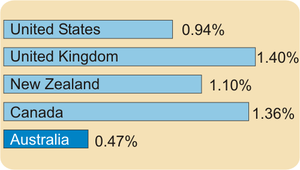Will Australia Count in the Future?
Many advances that make our modern world modern depend upon mathematics. This is a process that continues today. Just one example is the Human Genome project, where at the core, sophisticated mathematical methods are putting together millions of disparate pieces of information into a coherent whole, speeding up the process a hundredfold. Statistical methods are now central to using this information, matching genes to human illnesses.

It is reasonable to ask where Australia lies in this modern world. The answer is not very comforting - Australia is not educating enough students in the mathematical sciences to meet current needs and the future looks even worse. Recent data from the OECD gives the number of graduates in 2006 across a number of disciplines for major countries. As statisticians, we are cautious about the use of such data since there are real problems of definitions. What is a graduate? What are the mathematical sciences? What is a university? However, if you look at the countries that have university systems closest to ours, a reasonably reliable picture emerges as shown at right.
The proportion of graduates in the mathematical sciences in Australia is about half of that in the United States and New Zealand and about a third of the others. This is the result of a decline in Australia over recent decades.
The reasons for this are complex. Undoubtedly, they start with the way that mathematics is taught in schools. Reports such as that of the Australian Deans of Science in late 2006, highlight a shortage of fully trained mathematics secondary school teachers. We can only assume that teachers from other disciplines are having to teach mathematics, frequently passing on their lack of comfort with the subject to their pupils. There is also a problem of balance - while Australia has done much to ensure that all students achieve at least a minimum level, this appears to have been at the expense of encouraging and extending those with natural talents in mathematics. Some states report a drop since 1994 of more than 30% in students studying advanced mathematics in Year 12. This leads to fewer students going to university to study mathematics and hence fewer graduates. But with fewer mathematics graduates, where will the future mathematics teachers come from?
The United Kingdom recognised this problem in 2004 in the report Making Mathematics Count, generally termed the Smith report. The problem was described as a spiral, where insufficient graduates would lead to too few future students, making the problem worse. As a result, the government established mathematics as a priority area and significant effort was put into encouraging students to study the mathematical sciences at school and at university levels. This is already showing promising results. We hope for, but are yet to see, a similar initiative in Australia.
Working at the forefront of mathematics applications in industry and government, Data Analysis Australia is acutely aware of these problems. We also see the long term problems that this will raise for our clients. It is critical that mathematicians, and those who rely upon mathematicians, act together to urge decision makers to address what is already a national problem.
Data Analysis Australia is fortunate that it is still able to attract outstanding graduates to train as consultants. We are also contributing to the profession. For example, for many years we have sponsored the Western Australian Young Statisticians workshops that encourage students to think of a career as statisticians. We also have ongoing comprehensive internal professional development. This means that our clients can continue to have access to such expertise.
For further information, please Contact Us.
July 2009
